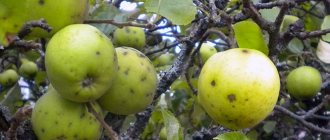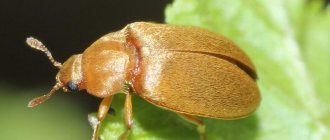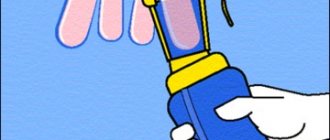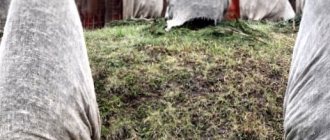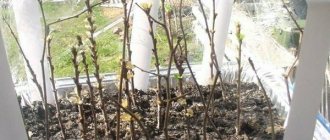Why is disinfection needed?
Domestic chickens are not the cleanest birds. When kept in one room, especially a cramped one, they are constantly exposed to conditions of high humidity and heat. Leftover feed, feathers and excrement inevitably accumulate in the chicken coop. Even regular cleaning cannot prevent the appearance of bacteria and viruses, as well as fleas, ticks and other parasites.
Microorganisms and insects in the chicken coop can cause serious illness in poultry. To prevent infectious outbreaks, the premises should be disinfected. As a rule, preventive treatment is performed 2-4 times a year, and therapeutic treatment is performed as needed.
It is mandatory to disinfect the chicken coop in spring and autumn.
Where are they hiding
Bloodsuckers attack at night, so you should not look for them on the body of birds. Just as it’s not easy to get rid of bedbugs in a chicken coop, it’s also not easy to find insects. Most often they hide in small crevices of the structure. When inspecting a building, it is important to pay attention to places where chickens stay for a long time - roosts, nests, etc. If you notice gray dots in the cracks, then these are bloodsuckers.
To identify parasites, it is better to check the room at night; they are active, and at this time it will be easier to find them. It is worth paying attention to places where it is constantly warm; it is convenient for parasites to hide there.
Types of disinfection
Disinfection of a chicken coop at home is divided into three main types:
- Preventive. Treatment is carried out once every six months or quarterly, when the seasons change.
- Forced. Procedures are carried out urgently when parasites are detected or after an outbreak of disease among birds.
- Final. The treatment is carried out after laboratory confirmed complete recovery of the birds from the detected disease.
In addition, several types of disinfection at home can be distinguished according to the chosen disinfection method:
- Chemical - to destroy parasites and bacteria, drugs in liquid, powder or gaseous form are used. The products can be aggressive in composition or safe for the birds themselves.
- Physical - disinfection is carried out using ultraviolet or quartz lamps, boiling water or hot steam.
- Biological - the method is used relatively rarely. In the process of destroying bacteria and insects, living organisms are used, which are natural enemies for pathogens, but in themselves do not pose a danger to chickens.
- Mechanical - the method involves the complete replacement of perches, water and food containers, as well as the removal of flooring and the top layer of the floor.
In case of serious outbreaks of diseases in the chicken coop, the listed methods are combined with each other. This allows you to achieve maximum effect at home.
Preventive treatment of the poultry house is carried out before moving in new chickens.
Signs of bird infection
Insects cause significant discomfort to the bird, as evidenced by a number of signs:
- Concern appears: the chickens peck themselves, trying to catch the bloodsucker, tearing out feathers in shreds.
- Stop eating food.
- They lose weight sharply.
- They don't lay eggs.
- Multiple bald patches appear on the feather cover.
- Chickens slow down in growth and development.
- Chickens stop sleeping
- Eyes become inflamed.
Lack of proper treatment leads to the death of the bird population
Lack of proper treatment leads to the death of the bird population. The risk of being attacked by harmful insects especially increases during molting. Lice love fresh feathers.
It is difficult to diagnose chicken lice with the naked eye. The most favorite habitats of lice:
- under the wing;
- in the neck and legs;
- around the anus;
- near the eyes.
To detect parasites, they use a special method of heating the chicken for 10 minutes - thermotropism. As a result, insects crawl out.
Preparing the chicken coop before disinfection
Before carrying out disinfection treatment at home, it is necessary to prepare the chicken coop. Namely:
- remove all birds from the premises;
- completely clear the floor of bedding and remaining droppings, remove uneaten food from the feeders;
- sweep and vacuum the walls, clean the ventilation holes;
- sweep the floor from any remaining debris and wash off the lime from the walls.
Before disinfection treatment at home, it is necessary to remove all equipment from the chicken coop. Perches, drinking bowls, nests and feeders are washed in a soda solution prepared at the rate of 200 g per 10 liters of water and dried in air.
Most of the products that provide high-quality disinfection of the chicken coop are toxic to humans. Therefore, before the procedure, it is necessary to wear protective clothing that covers your arms and neck, and durable shoes with thick soles. Be sure to use rubber gloves for your hands and a face respirator, and in some cases even a gas mask.
How to disinfect a chicken coop yourself
By following the rules for sanitizing the premises, you can cope with the disinfection of the chicken coop yourself.
Preparation
First you need to prepare everything you need to complete the job:
- clothing covering most of the skin;
- personal protective equipment (rubber gloves, respirator, goggles);
- tools and materials (sprayer, bucket, broom, shovel, plastic bags, rags, special preparations, water).
All equipment used in sanitation should be washed using detergents after finishing work. Clothes also need to be washed and rinsed several times in warm water. The respirator must be disposed of.
How and how to disinfect a chicken coop at home
When sanitizing the chicken coop on your own, you can use folk remedies and purchased medications. Both of them show good efficiency.
Preparations for disinfecting chicken coops
Chemicals for disinfecting chicken coops are used mainly for identified diseases in poultry. The advantage of purchased drugs against bacteria and fungi is that most of them are safe for birds and humans.
Virocide
The Belgian product is a brown liquid with a faint odor. The composition includes quaternary ammonium compounds, isopropanol and glutaraldehyde. The drug is available in 20 liter canisters, does not pose a danger to poultry and humans, and works even at low temperatures.
To carry out disinfection at home, prepare an aqueous solution of Virocide:
- for wiping or irrigation for preventive purposes - with a concentration of 0.25%;
- to eliminate identified infections - with a concentration of 0.5%;
- for preventive or forced disinfection by spraying - at a concentration of 25%.
When treating an infected chicken coop at home, the product is left on the surfaces for an hour, when carrying out routine sanitation - for half an hour.
After disinfection with Virocide, you need to wash drinking bowls, feeders and perches.
Glutex
Glutex concentrate works well against all known fungi and pathogenic microorganisms that are dangerous to poultry at home. To prepare the solution, it is necessary to dilute the drug with water in the following proportions:
- for prevention - 1:100;
- for therapeutic treatment - 1:200.
The time before washing off the drug is three hours, the consumption per 1 m2 should be at least 0.3 liters.
Glutex can be used, including against poultry tuberculosis
Ecocid-S
The disinfectant comes in the form of small pinkish-gray granules with a faint lemon odor. The main active ingredient of the drug is potassium peroxomonosulfate.
For preventive and forced treatment at home, prepare a solution with a concentration of 1%. The product is applied to the surface using a sprayer at the rate of 300 ml per 1 m2 and left for an hour until washed off.
After treating the chicken coop with Ecocid-S, ventilation is required for six hours
Delegol
The disinfectant solution destroys viruses, fungi, gram-negative and gram-positive bacteria and mycoplasmas. It is used to treat surfaces and equipment in the chicken coop; the product remains active for a week.
For sanitary purposes, a solution with a concentration of 0.5-1% is prepared at home. The consumption for drip spraying should be 300 ml per 1 m2, and for aerosol spraying - 1 l per 100 m3.
The exposure time of the drug Delegol is six hours
Disinfection with salt solutions
You can disinfect a chicken coop at home from microorganisms, as well as for preventive purposes, using saline solutions. Sodium hypochlorite has a good effect, prepare it as follows:
- bleach and soda ash are mixed in equal proportions;
- pour the substances with water in a ratio of 4:10;
- leave to infuse for a day;
- During the first six hours, the product is often stirred.
The finished product is poured into a spray bottle and the chicken coop is treated at home using the aerosol method or spraying.
After using sodium hypochlorite, the poultry house is ventilated until the characteristic odor disappears. Attention! It is impossible to work with chlorine-containing saline solution if you have chronic respiratory ailments. Toxic fumes can cause asphyxiation even when using a respirator.
Disinfection of a chicken coop with iodine
Iodine monochloride in the form of a homemade bomb is suitable for treating a chicken coop at home. The solution is poured into a small jar, and then an aluminum plate or wire is placed in it.
As a result of the chemical reaction, pinkish smoke is released, which has disinfecting properties. The chicken coop needs to be treated with iodine for three hours, then the room is ventilated.
Iodine treatment at home can be carried out without removing birds from the house
Disinfecting a chicken coop with smoke bombs
If fungus, mold and parasites appear in the chicken coop, you can use two types of smoke bombs for treatment at home:
- Ammonia - they help well against any parasites and at the same time are harmless to the birds themselves, they serve as the prevention of pulmonary diseases.
- Sulfur - destroy insects and known bacteria with absolute reliability, but are toxic to chickens and humans.
It is not difficult to use checkers; they are placed evenly throughout the entire area of the poultry house and set on fire. The room is closed for 3-4 hours and then ventilated until the smell disappears.
Attention! Sulfur bombs are very toxic; using them in the presence of birds is strictly prohibited.
Before using smoke bombs, drinkers, feeders and equipment are removed from the premises.
Disinfecting a chicken coop with lime
You can treat the chicken coop against diseases or as a preventive measure at home with bleach. The method of application is very simple, the dry product is poured into a basin and left in an empty room for a day. The vapors released by the substance reliably destroy pathogens.
You can also use slaked lime solution to whitewash walls. The fluff is diluted in cold water in a ratio of 1:3 and left for a day, and then applied to the walls at the rate of about 500 ml per 1 m2.
After disinfection with bleach, you need to thoroughly ventilate the chicken coop to avoid poisoning the birds.
What do chicken parasites look like?
Chicken lice
Chicken lice are parasitic external insects that feed on the blood of mammals. They have microscopic dimensions - within 0.4-0.5 mm. The body is reddish-brown, flattened. After saturation, the filling of the stomach is visible.
Paws with small claws help them fixate on the victim. The head is quite large and mustachioed. The mouth contains chewing jaws (mandibles), with a sharp process for sucking blood. Externally, the chicken louse is similar to the human louse, which is where the name comes from.
Parasites emerge from egg-shaped capsules that develop over the course of a week. The louse nit is a translucent cocoon, whitish in color. Having hatched, the young begin to develop rapidly, moving into the adult stage. This leads to active distribution.
The lifespan of lice is 1 month, which they spend only on birds. There are varieties of lice that feed on both feathers and blood. Then bald spots appear on the bird.
Appearance
Chicken fleas can be distinguished from other insects due to their small size (up to 2 mm), jumping ability and high mobility. In addition, animals have:
- developed visual organs;
- elongated mustache;
- pronounced hunchback;
- lateral flattening of the chitin shell.
The average lifespan of these ectoparasites is 1.5 years, during which time they are capable of producing at least two thousand fertilized testicles. When an adult female lays eggs every day, they are scattered using her hind legs. When exposed to warm conditions, larvae emerge and feed on dander and chicken droppings. After pupation of the larvae, adult insects are formed that feed on the blood of poultry.
Signs of parasitism
When entering the barn, you can feel the appearance of small brown insects on the skin - chicken fleas, which is a sign of their progression in the room. Poultry become infected with the described parasites through:
- wild relatives;
- migration of fleas from nearby chicken coops;
- contaminated straw;
- other birds that ended up in the barn.
In the first stages of the appearance of parasitic insects in the chicken coop, it is difficult to identify them. The following signs should alert homeowners:
- the appearance of small blackish-brown moles on the head;
- nervousness of birds;
- development of bald spots on the body;
- excessive manifestation of appetite.
Parasitic insects can be accurately identified by a detailed examination of the chicken. Most fleas are found around:
- beak;
- eye;
- ridge
Blood vessels lie shallow here, from which ectoparasites draw the nutritional compounds necessary for their life.
How to disinfect in the presence of birds
Preventive sanitary treatment at home can be carried out using safe means without removing chickens from the premises. During the disinfection process, the doors and windows of the building are opened for good ventilation, and forced ventilation is turned on if possible. Dishes and equipment are removed from the room, old bedding is changed, and dust accumulations are removed using a vacuum cleaner.
Handles, latches and other elements must be treated with a disinfectant solution. Metal surfaces at home can be heated using a gas burner - the high temperature will reliably destroy pathogens. To clean the air, walls and floors of microorganisms, iodine bombs or safe liquid agents, for example, Ecocid-S, are used; the exposure time is reduced to half an hour.
Important! You can treat the chicken coop in the presence of birds no more than once a month.
It must be taken into account that light sanitation at home is preventive in nature. It does not completely disinfect the poultry house, but only reduces the number of pathogens. Forced disinfection during serious disease outbreaks is always carried out in an empty room.
How to remove chicken lice
Parasite control measures involve two successive stages: treatment of the poultry flock, then housing. All this is done as quickly as possible to prevent the spread of the epidemic. The process involves the use of pesticides and folk remedies.
If a problem is detected, all birds are moved to a new place, and the chicken coop is disinfected.
Special insecticidal preparations are purchased at a veterinary pharmacy. Regardless of the chosen method, the bird is treated twice: immediately and after a week. It is important that chemicals do not leak into the birds' eyes and beaks.
If a problem is detected, all birds are moved to a new place, and the chicken coop is disinfected
What drugs should I use?
There are many commercially available products that help cope with mallophagosis (infection with external parasites). Their effect is local: they kill pests, but do not cause pathological harm to the bird.
The most common forms of release:
- Drops that are enough to apply in small quantities to the affected areas. Suitable for use for a month, which is enough to destroy larvae and adults. Contraindicated for chickens and weakened birds.
- Sprays with a prolonged effect on adult lice and nits. Each chicken is completely sprayed with them.
Several best drugs
If there is a large accumulation of lice on a bird, it is recommended to use the drug “Butox”. It comes in powder or liquid form and dissolves in water, according to the dosages indicated in the instructions on the package. The resulting solution is used to pollinate the chicken.
When there are few parasitic clusters, drops are used: Bars, Frontline, Neostomazan. Sprays that are also effective are: Dichlorvos, Reid, Get, as well as liquid solutions of Tetrix, Karbofos, Executioner.
Chemical insecticides against chicken lice
When there are few parasitic accumulations, drops are used. The most common chemical insecticides are:
- Insectoacaricidal powder - sprayed and rubbed into feathers. For a one-time treatment, 2-5 g is enough.
- Butox - the contents of the ampoule are dissolved in four liters of water.
- Beafar, Frontline - an insecticidal spray that is used to spray the chicken until the feather cover is completely moistened.
- Promectin is an effective drug for treating chickens by mixing it into drinking water.
For treatment, you can use the following formulations: Stomazan, Neostomazan. Due to their toxicity, they are contraindicated for laying hens and poultry going to slaughter. Any treatment must be repeated after 8-10 days to destroy the remaining larvae.
Folk remedies
Along with chemical means of control, there are folk remedies that are no less effective in terms of impact. The most common:
- Table vinegar: dilute in water (take 1:3 proportions), and pollinate the bird from a spray bottle.
- Kerosene: completely exterminates adult beetles, to a limited extent – larvae. Each chicken is processed and transferred to another room.
- A mixture of alcohol, kerosene and gasoline: the ingredients are combined in equal proportions, and then applied to the damaged skin areas of the bird. The method allows you to destroy lice nits.
- Herbal infusion: 300 grams of a mixture of wild rosemary, chamomile and tansy, brew with six liters of boiling water. Boil for a quarter of an hour and cool. The method is suitable for minor lice infestations.
To repel pests, a kerosene-ammonia solution is applied to the bird’s neck, and bunches of wormwood, wild rosemary, and tansy are hung in the chicken coop.
To repel pests, apply a kerosene-ammonia solution to the bird’s neck, and hang bunches of wormwood, wild rosemary, and tansy in the chicken coop.
Birch tar
Birch tar (a product of birch bark distillation) is applied to the bitten skin of birds and itchy areas of the body. Thanks to the resinous smell and thick consistency, the number of fleas on birds gradually decreases.
The wound-healing effect of the drug can quickly heal wounds on the skin of animals, causing a quick recovery. Birch tar can also poison parasites in a chicken coop by fumigating the room with it. To do this, about a kilogram of dry sawdust is combined with 100 ml of birch tar and left to infuse for 1 hour. Charcoal is lit in a metal container until it glows and sawdust soaked in tar is laid on top. A smoking device is placed in the barn where sick animals were previously located for 5 hours. Next, open the windows and doors for complete ventilation. This fumigation should be done up to 3 times within ten days.
Herbs
The lice beetle and other ectoparasites cannot stand the smell of some herbs. They can be hung in rooms where chickens are kept to kill parasitic insects. Such herbs are:
- sagebrush;
- celandine;
- geranium;
- tansy;
- marigold.
From time to time, herbs hung indoors should be replaced with fresh specimens so that the achieved effect does not weaken.
Decoctions and infusions
You can also kill fleas with decoctions and infusions.
Recipe No. 1: Chamomile infusion
Young chamomile shoots should be poured with a liter of boiled water and allowed to steep for 24 hours. Then the resulting “medicine” should be rubbed into the feathers for several days until the ectoparasites completely disappear.
Recipe No. 2: Wormwood decoction
It is recommended to treat the outer feathers and skin of sick animals with wormwood infusion until fleas disappear completely. The procedure should be carried out daily for 10 days. After this, the birds will look healthier and more vigorous.
Recipe No. 3: Tansy + wormwood
Tansy inflorescences (100 g), dry wormwood leaves (50 g) and 1 liter of boiling water are mixed together and then kept for up to 5 hours at room temperature. As soon as the folk remedy is infused, it is filtered and applied to the skin with feathers of chickens. You can also spray a barn where sick animals are kept with this infusion.
It is advisable to treat the premises and birds up to twice a month until the parasitic insects completely disappear. Such prevention will protect chickens and chickens from repeated invasion of blood-sucking fleas.
Ash
Fine ash powder is an excellent bath for bathing animals with fleas. It is recommended to destroy ectoparasites at home using ash-sand mixtures or stove ash. To do this, small containers with ash are installed on the territory of the chicken coop, where sick birds can periodically “bathe”.
An ash-sand composition (1:1) is also effective. When chickens bathe in ash, the tiny particles shake off parasitic insects from their skin, leaving them in the environment. It is difficult for the latter to move among the ash powder, which is why they quickly die.
What to do if there are a lot of smokes?
The fight against flea infestations in the chicken coop, where there are a lot of chickens, should also be carried out! For these purposes, medicinal baths are good, where each of the affected individuals is dipped in turn.
The basis of therapeutic baths is clean and cool water (100 l), in which Butox (90 ml) is dissolved. Before using the solution, let it sit for 20 minutes, after which you can start bathing. To do this, 2/3 of each chicken is lowered into a large container one by one, making sure that water does not get into the animal’s mouth.
Before the bathing procedure, chickens should be well fed and watered so that the birds do not start drinking the Butox working solution, which can cause poisoning in their body.
When birds are immersed in water, the disinfectant solution will penetrate the fleas' bodies, causing their death. Each chicken should be kept in water for up to 20 seconds, during which the ectoparasites living on its skin will begin to die. The used solution should be poured away from the animal walking area.
Disinfection of a chicken coop after a bird illness
If a viral or bacterial outbreak is detected in a chicken coop, it is necessary, first of all, to treat the population and transfer the birds to another building or outdoor pen. The old premises are thoroughly cleaned at home, namely:
- dispose of litter;
- feeders and drinking bowls are thoroughly washed with sanitary products;
- remove the top layer of coating from the floor, and renew the lime on the walls;
- treat the room with a preparation selected taking into account the specifics of the disease.
The bird is returned to its original place only after final recovery, after receiving the appropriate test results.
Disinfection after illness in the poultry house is carried out several times in a row.
Prevention
It is possible to deal with parasites and pathogenic microflora, but it is easier to carry out preventive measures in a timely manner to protect birds from serious diseases. Events are held in compliance with the following rules.
- Treatment of the premises must be regular (at least once every 6 months or at least a year). The poultry house is disinfected regardless of whether there are problems with parasites/diseases or not. Experienced poultry farmers recommend the frequency of disinfecting the chicken coop once every 2 months.
- To prevent the development of microorganisms, it is necessary to install a ventilation system in the poultry house. Even a primitive design will provide air flow. In a ventilated room, the growth of bacteria and viruses is greatly reduced.
- You should clean the chicken coop 1-2 times throughout the week. The litter is thoroughly shaken out outside. Bird nests and perches are also cleaned (it is better if they are removable).
- It is recommended to sprinkle the swept floor with a fresh portion of sand. Birds are more comfortable with it than with straw or pine shavings.
- During cleaning, a passage is made over all surfaces, including walls.
- As a preventive measure, the walls are whitewashed with lime.
Do not despair when identifying alarming symptoms in birds. Timely treatments and regular preventive measures will help get rid of the problem and subsequently maintain the poultry house in acceptable sanitary conditions.
Watch a video about an ancient method of disinfecting chicken coops and other utility rooms:
What is better - to carry out disinfection yourself or to involve professionals?
There are obvious benefits to having your coop professionally sanitized. Specialists use reliable, expensive drugs to destroy pathogens and can guarantee the maximum effect of the procedure. In addition, processing the poultry house by professionals does not take much time and does not require effort on the part of the owner of the chicken coop.
The disadvantage of turning to specialists is the need for financial investments. It is much more profitable to disinfect the poultry house with your own hands at home.
Ideally, it is recommended to alternate self-treatment with calling professionals. You can contact specialists once a year for general disinfection of the premises or during outbreaks of serious diseases, when the maximum effect is more important than the cost of the procedure. Routine preventive treatments at the beginning of each season are more convenient to carry out independently; they do not require high qualifications and take little time.
Treatment for infections
The disinfection procedure must be carried out using certain drugs. It is easier to get rid of microbial infections. There are many products on the market that can eliminate the problem in 1-3 treatments.
Things are more complicated with viruses. They do not accept even revolutionary disinfection methods well. Among the drugs that have an antiviral effect, the following stand out: Virosept, Virotsid, Bianol.
From parasites
Disinfection against parasites is carried out as a preventive measure once a year. If insects are detected, unscheduled disinfection is carried out using special preparations. They must be selected taking into account the spectrum of action. Preference is given to those agents that are active against several types of parasites.
It is impossible to remain idle when identifying insects. Meat and eggs may contain substances hazardous to humans. And birds suffer no less from harmful insects, losing productivity and activity.
Features of the disinfection procedure:
- mandatory change of litter;
- changing lime whitewash on the walls;
- parallel treatment of poultry.
Means for disinfection work
What preparations are used to treat a chicken coop where poultry lives? There are 2 types of purchased drugs. Cheap and simple, which is used in large poultry farms, it is difficult to buy in small quantities. The packaging of aerosols is designed for large spaces, which is not suitable for home farms. Their chemical composition is toxic and if inhaled there is a risk of lung damage. Chemical burns can seriously harm a farmer.
If you carry out disinfection work on an enclosure or cage at home, it is advisable to use publicly available solutions:
- 2% sodium;
- 3% formaldehyde;
- 5% soda with calcium;
- 4% xylonaptha or creolin.
If you compare the prepared solution with bleach, it is better to choose lime with greater effectiveness in combating parasites. A light solution of appropriate concentration and dosage will disinfect the room better than store-bought drugs. Treating with lime in the correct proportion will save the chicken coop from corrosion and negative environmental influences.
Purchased products are characterized by a high concentration of water and the presence of many excipients. You should not reduce or increase concentration on your own. The changed dosage will either not help or harm the birds.

